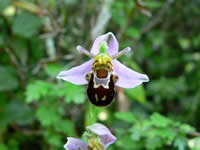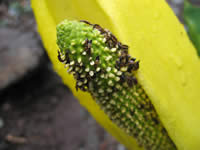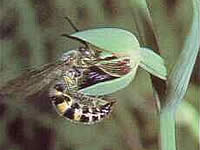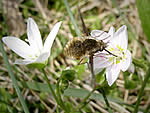USDA Forest Service Celebrating Wildflowers
|
|
|
Plant Pollination StrategiesMimicry
In a number of flowering plants, especially orchids, a plant uses mimicry to entice the insect pollinator to visit the flower and successfully pollinate it with no reward of food to the pollinating insect. Many flowers that are dark red or red-purple produce a scent that is similar to the scent of rotting flesh. In this case, the pollinator visits the flower believing that there is a meal or a carcass on which to lay its eggs. Female blowflies will land on these flowers, lay their eggs, and in the process of moving about the flower inadvertently pollinate it. However, when the eggs hatch the maggots die, as there is no rotting flesh to eat. In other cases the duped pollinator lands on the flower and moves around the flower and inadvertently pollinates the flower while trying to find the rotting flesh to eat. Besides the need to eat, pollinators need to mate in order to produce the next generation and ensure the continuation of the species. Many orchids take advantage of this innate behavior to reproduce. The warty hammer orchid of Western Australia produces a chemical scent that is almost identical to the pheromone that the female thynnine wasp releases when she is sexually receptive. The orchid's labellum (lower lip) is also shaped similarly to the body of the female wasp. The male thynnine wasp grasps the imitation female and tries to fly off with her to mate and in the process crashes into the flower structure containing the pollen and the stigma. Pollen from one orchid is carried to another and pollination occurs. The male thynnine wasp's desire to mate as many times as possible lends to this trait of pollinating the warty hammer orchid.
Fun FactSome plants take advantage of the sex drive of specific insects. The Copper Beard Orchid has a floral structure and scent that mimics the female scoliid wasp. The male wasp attempts to mate with the flower (pseudocopulation) and in doing so provides the pollination service as they travel from one orchid to another attempting to mate with other "female wasps." Bower, C. C. Observations on the Pollination of Calochilus Campestris R.Br. (PDF, 30 KB). Orchadian Volume 11, Number 2, December 1993. |
|
| NOTE: PDF format links require the Adobe Acrobat Reader to view. | |
| top | Disclaimers | FOIA | Privacy Policy | Quality of Information | Photo Credits & Use |
Location: http://www.fs.fed.us/wildflowers/pollinators/plantstrategies/mimicry.shtml
Last modified: Monday, 19-May-2008 14:02:15 EDT



